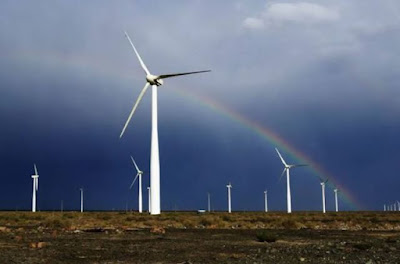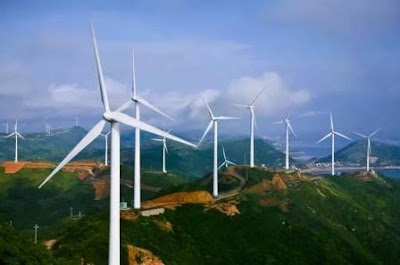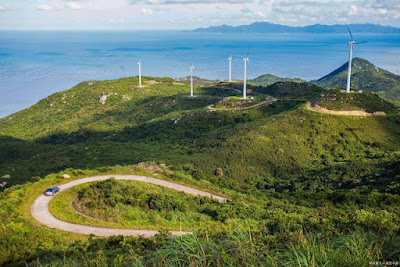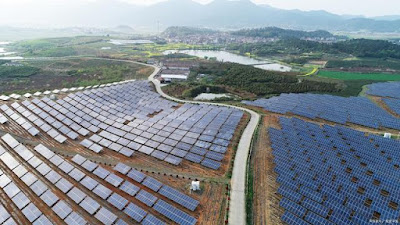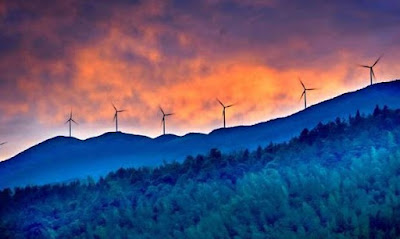In recent years, if you drive in the wilderness of northwest China, you will probably see wind turbines that look like "big windmills" spinning slowly on the horizon.
This kind of big windmill doesn't feel so spectacular when you look at it from a distance. If you get close, you will find that it is terrifyingly big. Usually, the height is more than 60 or 70 meters, and the highest can even reach more than 200 meters, with at least a dozen layers. The building is so high, and a blade is at least thirty or forty meters long.
Seeing such a large object, some people must be wondering how expensive this one is? How much electricity can these "big windmills" generate in each spin and how long will it take to recover the cost?
With the rapid development of wind power generation, large windmills are becoming more and more common
China's traditional power generation method is dominated by thermal power. According to data from the National Bureau of Statistics, the national power generation from January to December 2021 will be 8,112.18 billion kWh, of which thermal power generation will be 5,770.27 billion kWh, accounting for about 71.13% of the total national power generation.
It can be seen that thermal power still occupies a dominant position, but new power generation methods are also developing rapidly. In 2021, the national renewable energy power generation will reach 2,485.3 billion kWh, of which wind power generation will reach 655.6 billion kWh, a year-on-year increase of 40.5%, and the utilization hours will reach 2,246 hours.
In terms of installed capacity, the cumulative installed capacity of wind power in China in 2021 will reach 328.5GW, a year-on-year increase of 16.7%, and the growth rate is faster than that of the world. The cumulative installed capacity of wind power accounts for 39.2% of the world.
In 2016, the cumulative installed capacity of wind power in China was only 148.6GW, which doubled to 328.5GW in just five years.
It can be seen that the growth rate of wind power generation is very fast. Nowadays, more and more "big windmills" are standing in the mountains or plateaus. So how much does it cost to rely on "big windmills" to generate electricity?
The cost of generating electricity from a "big windmill"
Let's first take a look at the cost of a "big windmill". Wind turbines mainly include blades, hubs, nacelles and towers. Different wind turbines have different costs due to different technologies and blade diameters.
The current market price is about RMB 3,000-3,500 per kilowatt. According to this calculation, if it is a 2MW unit, the purchase price is about RMB 6 million-7 million. If it is a 3MW unit, then the purchase price is probably between RMB 9 million and 10.5 million.
It can be seen that only from the cost of the generator set, the cost of a piece of equipment needs to be millions or even tens of millions. However, in practical applications, there are many other potential costs that need to be considered in addition to equipment costs.
For example, during the use of wind turbines, there will be strong noise disturbance to the surrounding environment, so at the beginning of construction, nearby villages may be arranged to be relocated collectively, and the resulting land acquisition compensation fee is also not small. expenditure.
Secondly, if the wind turbine is scrapped due to some kind of failure, the cost of manpower and material resources generated in the demolition and destruction of this equipment are all scrapped costs.
Of course, the daily maintenance, maintenance, parts replacement and other operations of wind turbines require cost input.
If these potential costs are taken into account, then the funds needed to develop wind power generation will be added. A large windmill can run, and it will require an investment of about 10 million yuan.
Does the "big windmill" make money? How soon to recover the investment cost?
So how much electricity can these wind-powered "big windmills" generate in one revolution? The investment cost is tens of millions, and how long will it take to pay back?
Taking the most common wind energy generator in my country as the standard, its specification is 2MW. If the wind speed is 12 meters per second, the power generation per hour of a windmill is generally about 2000 Kwh, and the speed of the fan blades per hour is about 1000 revolutions. Thus,it can generate about 2 kWh of electricity with one rotation.
After the large windmill generates electricity, it needs to be connected to the power grid to obtain income. We assume that the price of feed to the grid is RMB 0.4 per kilowatt-hour, then conservatively estimate that the annual operating income of a set of wind power generation equipment will be about RMB 1.5 million.
However, it is necessary to consider a practical situation. Not all wind power generation equipment is running all the time, and the wind in nature does not always maintain the strength enough to push the fan blades to rotate. For example, in North China, due to the low temperature in winter, it is difficult for wind power to operate normally.
It can be seen that, limited by many conditions, the annual use time of wind power generation equipment is relatively limited, which also makes the front of the "big windmill" to return to its original length again.
As mentioned above, the cost of a wind power generation equipment is tens of millions. Therefore, it will take at least 10 years for this wind power generation equipment to recover the cost of the previous investment.
What are the advantages of wind power?
It can be seen that it is not easy for wind power to achieve return, but the field of wind power has continued to develop rapidly in recent years, so what are its advantages?
Nowadays, the theme of environmental protection and greenness has been deeply rooted in everyone's heart. Over the years, new energy has achieved remarkable development in the fields of automobiles and parts. In the electric power industry, the application of new energy also conforms to the goal of green and sustainable development.
First of all, compared with wind power generation, traditional thermal power generation needs to consume a lot of coal and other resources, and in the process of converting it into electricity, it will release a lot of harmful substances, such as dust, carbon dioxide, sulfur dioxide, etc., which will produce a greenhouse effect.
And wind power can avoid this problem. In the process of wind energy conversion, it can be said that there is no pollution. It is an excellent choice to replace thermal power with wind power.
In addition, oil and coal are non-renewable resources, and these resources will eventually face depletion one day, while wind is a costless energy source in nature and will not face the problem of depletion. Therefore, although the investment is relatively high, for the future of mankind, we still need to vigorously develop the wind power business. In the long run, it will be beneficial to mankind without any harm.
